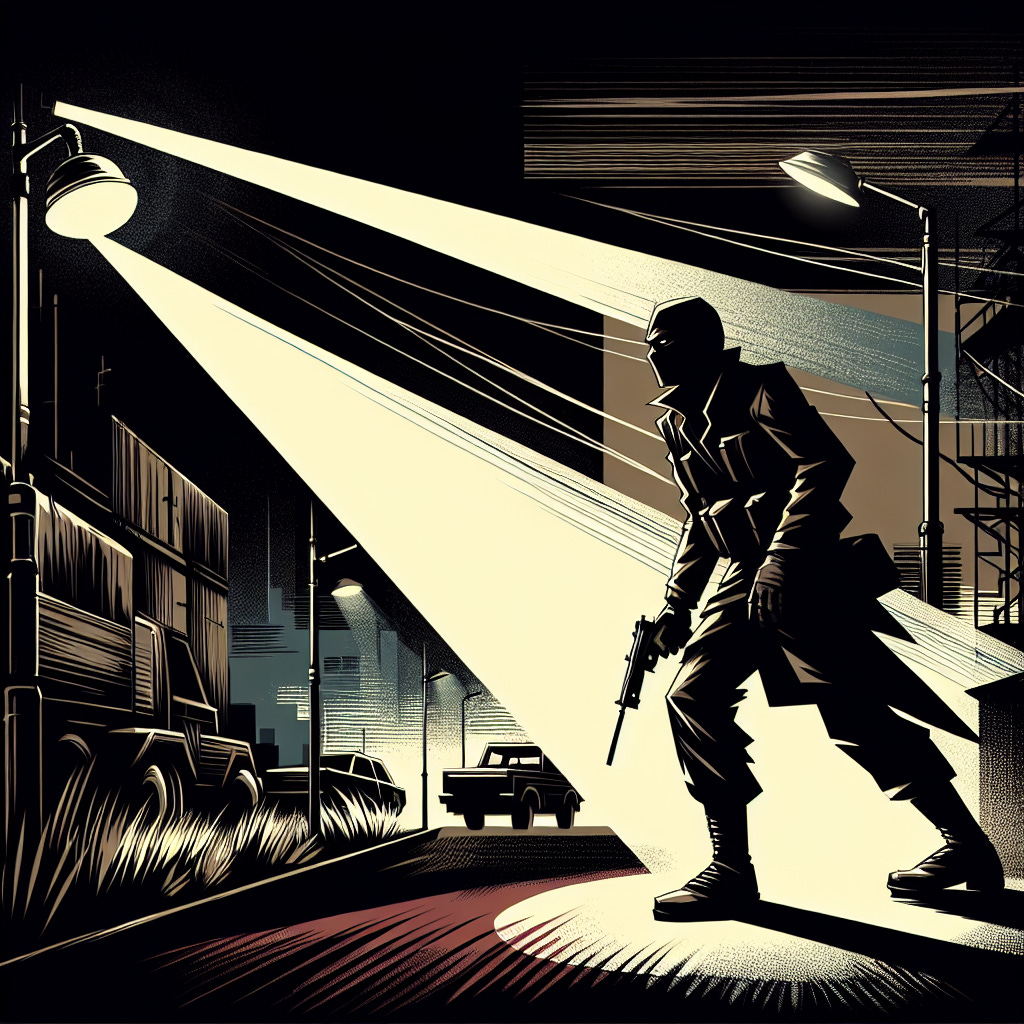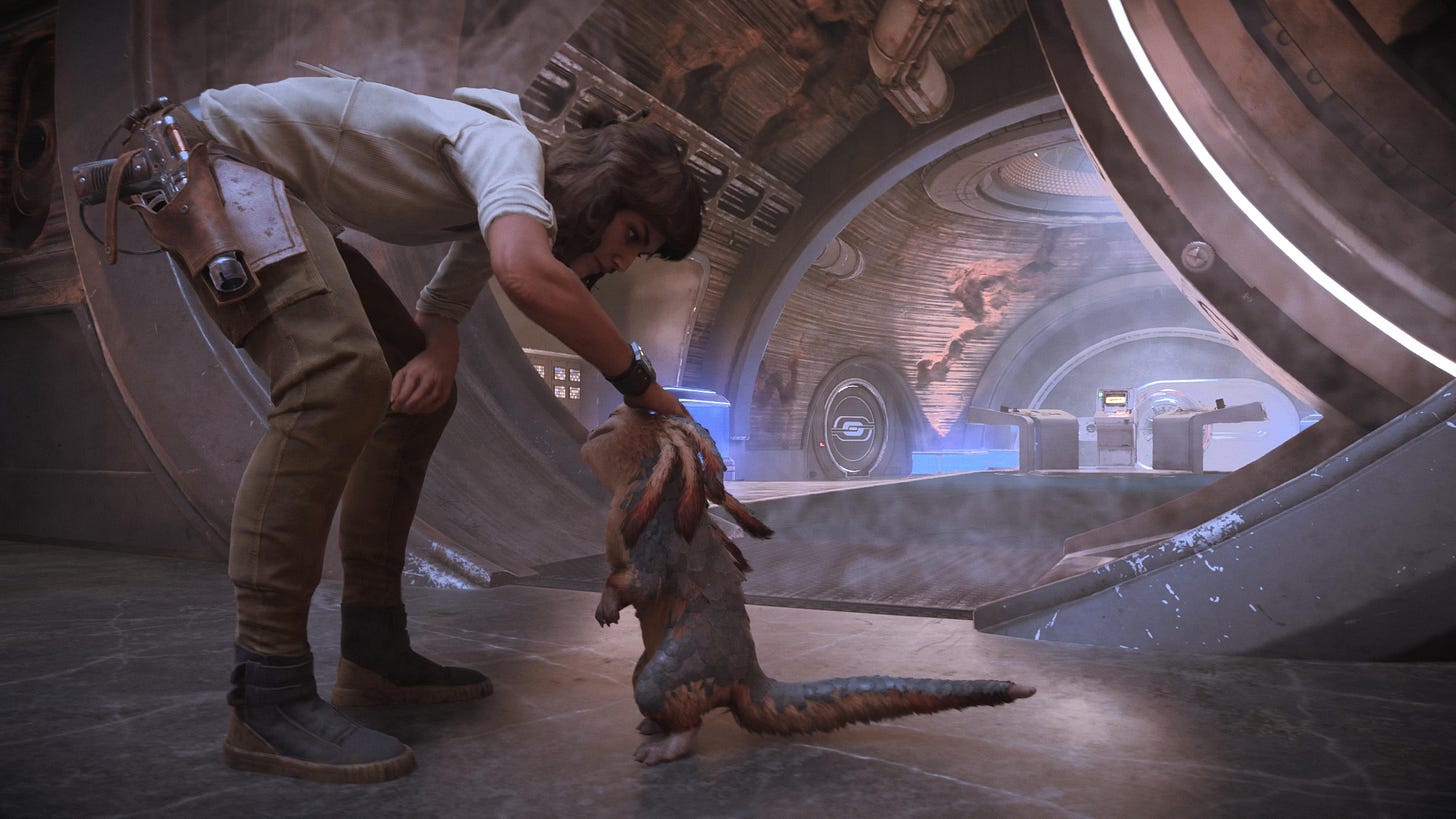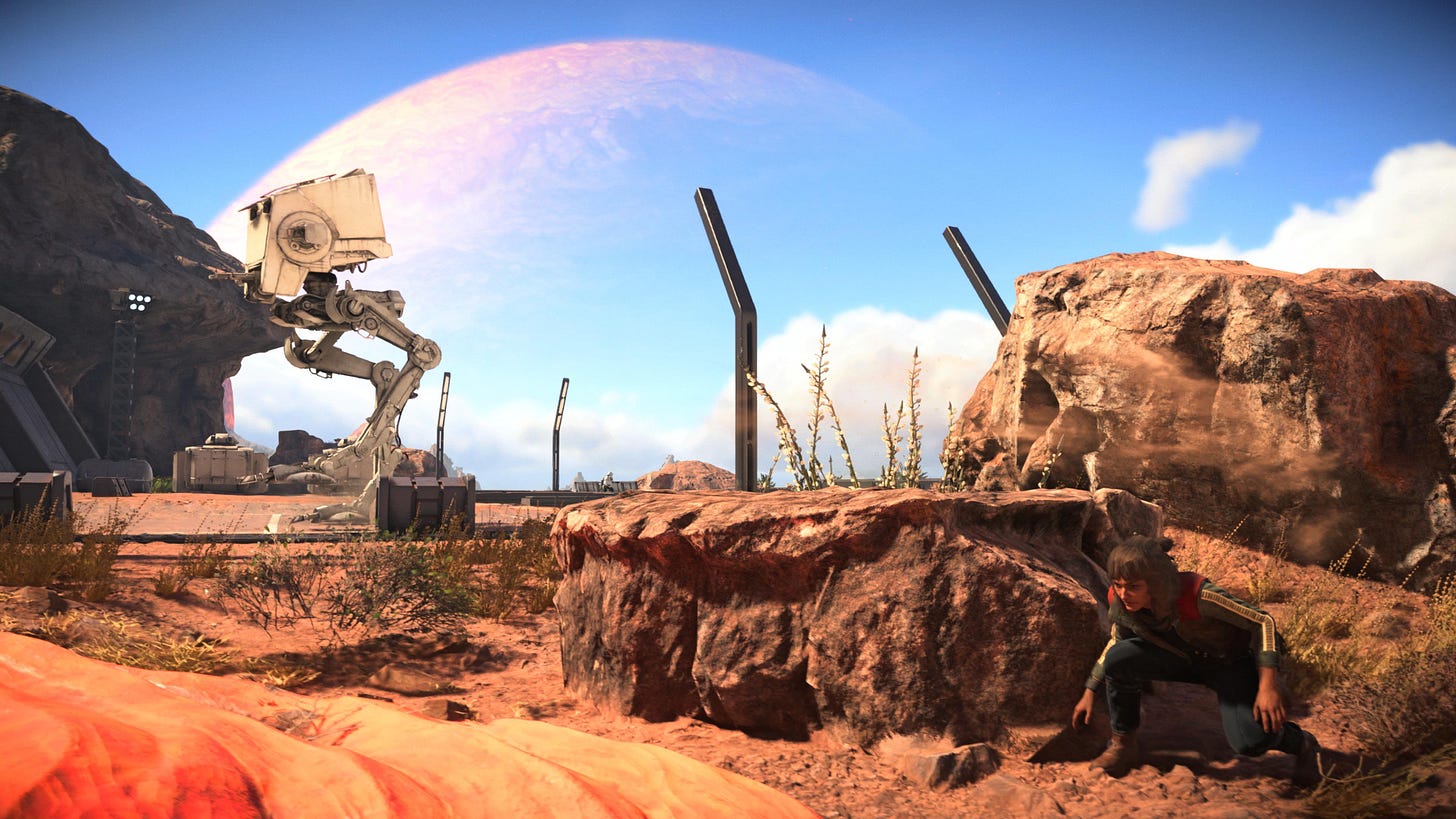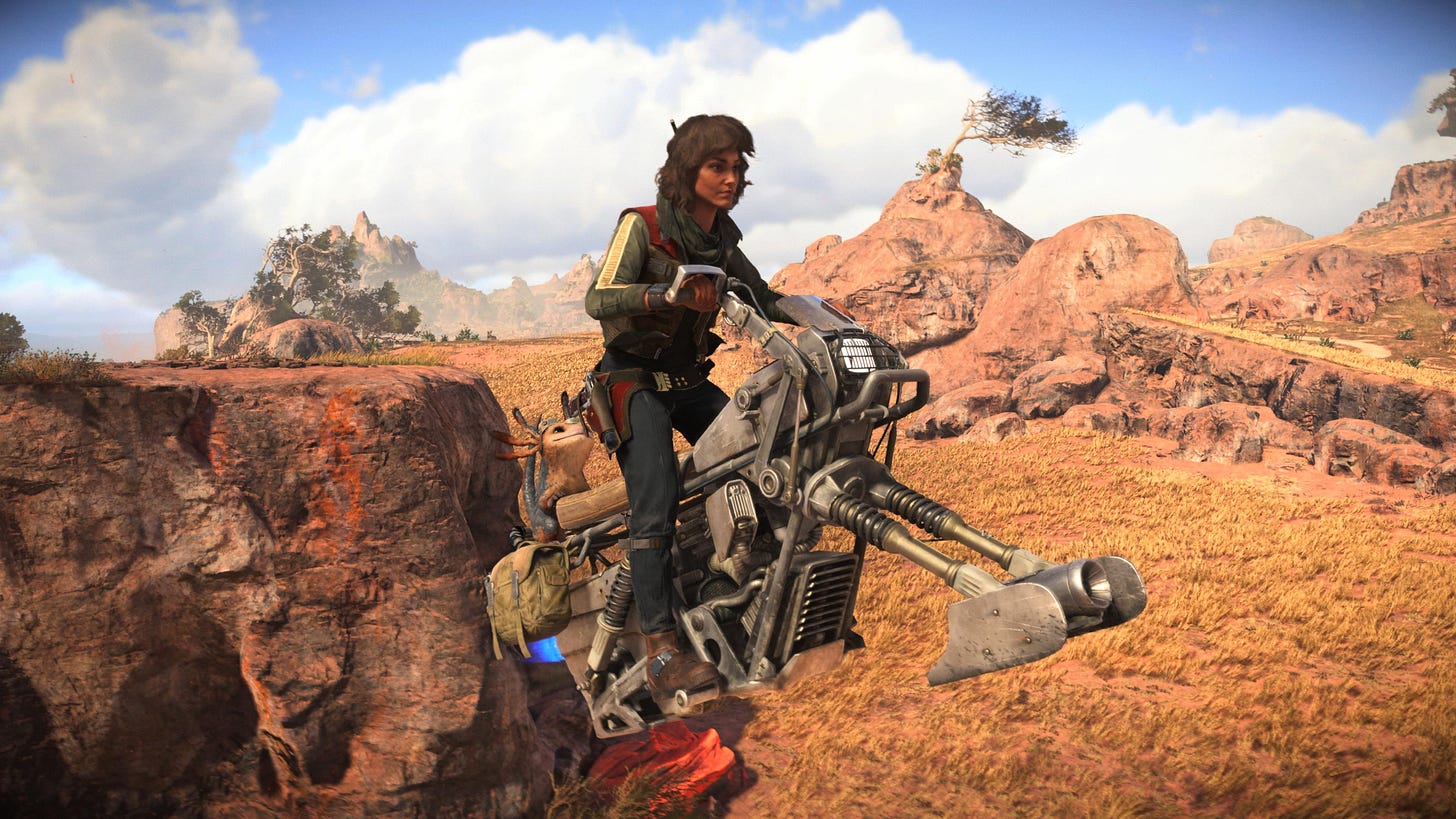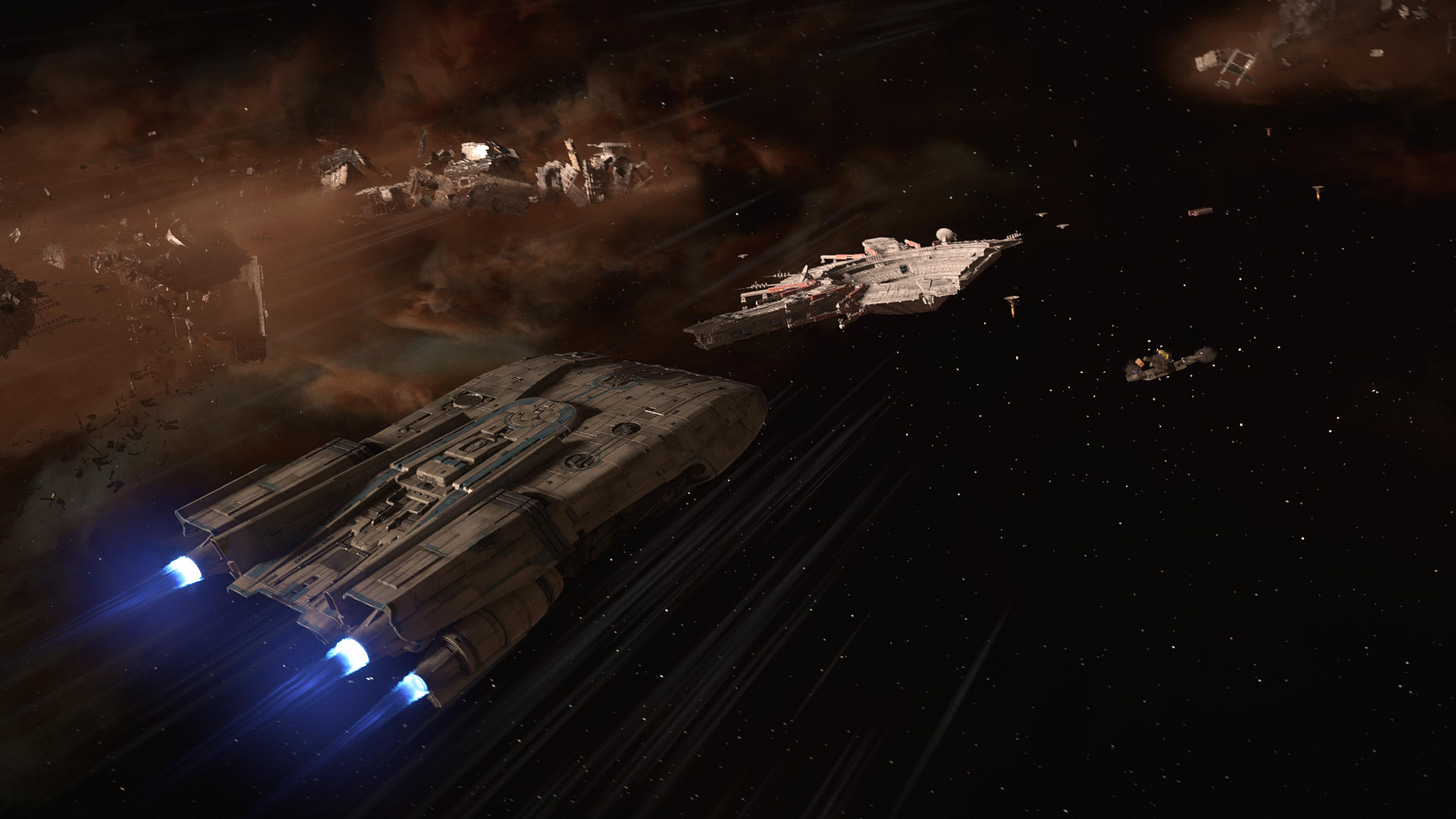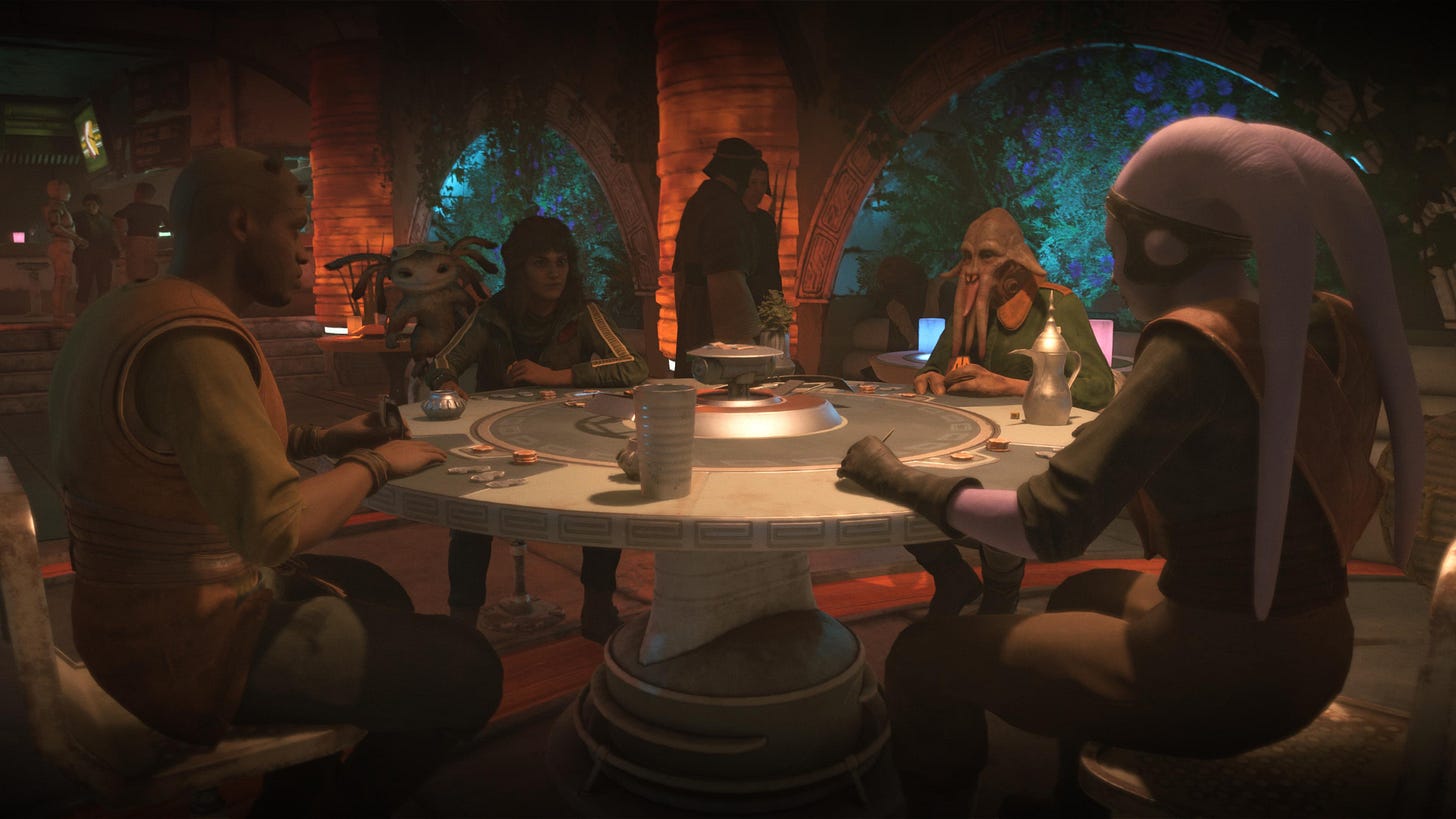No Bantha Poodoo, Star Wars Outlaws is awesome
George Lucas' brainchild has been around long enough to spawn innumerable hits and duds. This one falls in the former category.
Review: Star Wars Outlaws
Developed by Massive Entertainment and published by Ubisoft
Rating: ★★★★★★★★☆☆
I’ve always been fascinated by the concept of stealth in videogames. I should clarify that this is most definitely not because I’m particularly good at those games. I’m what would best be described as mildly above average. But there’s a pair of reasons for my words of praise for this genre.
The first is that there’s just something about sneaking around discreetly, using non-lethal weapons and often accomplishing one’s objective without firing a shot that I find so satisfying. Whether in the refined from seen in Splinter Cell or Metal Gear Solid titles, the innovative form evident in titles like Thief or the perfunctory but very functional take on stealth in the likes of the Horizon series, something about all that sneaking around just feels like Renaissance art amidst a sea of pop art in the form of the usual shooter titles. I should add that my appreciation for this type of game (or gameplay mechanic) was greatly enhanced after a reading of Kirk McKeand’s verbosely-titled and highly-recommended The History of the Stealth Game: From Metal Gear to Splinter Cell and Everything in Between.
The second is that the three most influential games in my formative years (which, for the purpose of this argument, I’m counting as ages 0 to 18) relied on some amount of stealth in one form or another. These, in reverse chronological order, are Metal Gear Solid 2: Sons of Liberty, Deus Ex and Prince of Persia. Where was the stealth in Prince of Persia, I hear you ask. Well, a handful of levels allowed you to get past a threat in a non-violent manner, provided you were willing to tiptoe around. I recall being extremely impressed by the game design of Deus Ex, which gave me the option to choose a heavy or light hand in most situations. And the second Metal Gear Solid was quite simply a masterclass in storytelling, swerves and stealth. Aside from a passing interest in the Star Wars universe, these reasons above were instrumental in me wanting to check out Star Wars Outlaws.
The world of outlaws
Now with that somewhat lengthy introduction out of the way, let’s get into our topic du jour. I had noted for another publication, following the game’s story trailer reveal, that it was exciting to see a “new title in this franchise that [didn’t] have Jedi or Sith at its front and centre”. And having spent around 20 hours on the game so far, this feeling has only been reinforced. For now, here’s the launch trailer:
Before I’d gotten my hands on the game, I was most enthusiastic about exploring the various biomes (for want of a better word) on offer: The grasslands and rolling hills of Toshara, the frozen wasteland of Kijimi, the grimy casino city of Cantonica, the jungle world of Akiva and of course, sandy Tatooine. I’d hoped to be handed a variety of decisions to be made, with consequences that would actually affect my playthrough. But overall, I just wanted to be entertained. After all, there’s only so much hand-wringing one can do about Star Wars or open-world tropes that have outlasted their ‘use by’ dates, before it all gets very dull, and you look around to see what else is going on.
With that in mind, I dove straight into Star Wars Outlaws. Following a suitably dramatic cutscene to kick things off on the right note, my introductions to protagonist Kay Vess and her sidekick Nix were made. Short and sweet, and very quickly, the in-game tutorials were upon us. I probably should’ve glanced through the text version of these immediately after, because the game doesn’t do a great job at explaining certain mechanics. Regardless, I powered on, eager to get into the grubby world of being a scoundrel.
Right off the bat, I took note of and greatly enjoyed the densely-packed and living-breathing areas that were Cantonica and Mirogana (on Toshara). The city design entailed a certain verticality that was quite fun to explore, NPCs seemed to be going about their business in a manner that did not seem entirely robotic, and the markets were a hustling, bustling delight to walk through. Special mention must go out to the variety of minigames with which Star Wars Outlaws and its various areas are replete. These range from rhythm-based lockpicking and Mastermind-like (or Wordle-like, if it helps) slicing/hacking games to QTE-driven food eating, an Asteroids-ish space shooter and card game Sabacc aka Blackjack-with-a-twist.
Stealth… in a galaxy far, far away
A couple of short missions into the game, I found myself in the thick of stealth action. I was quite looking forward to seeing how this game would execute the ol’ sneaky-sneaky stuff, wondering whether it would more closely resemble the polish we saw in Assassin’s Creed Mirage or the awkward clunk of Avatar: Frontiers of Pandora’s take on the stealth mechanic. A quick note on the latter: It’s nigh-on impossible to slip by undetected when you’re nearly 10-feet-tall. As it turned out, Star Wars Outlaws is cut from very different cloth.
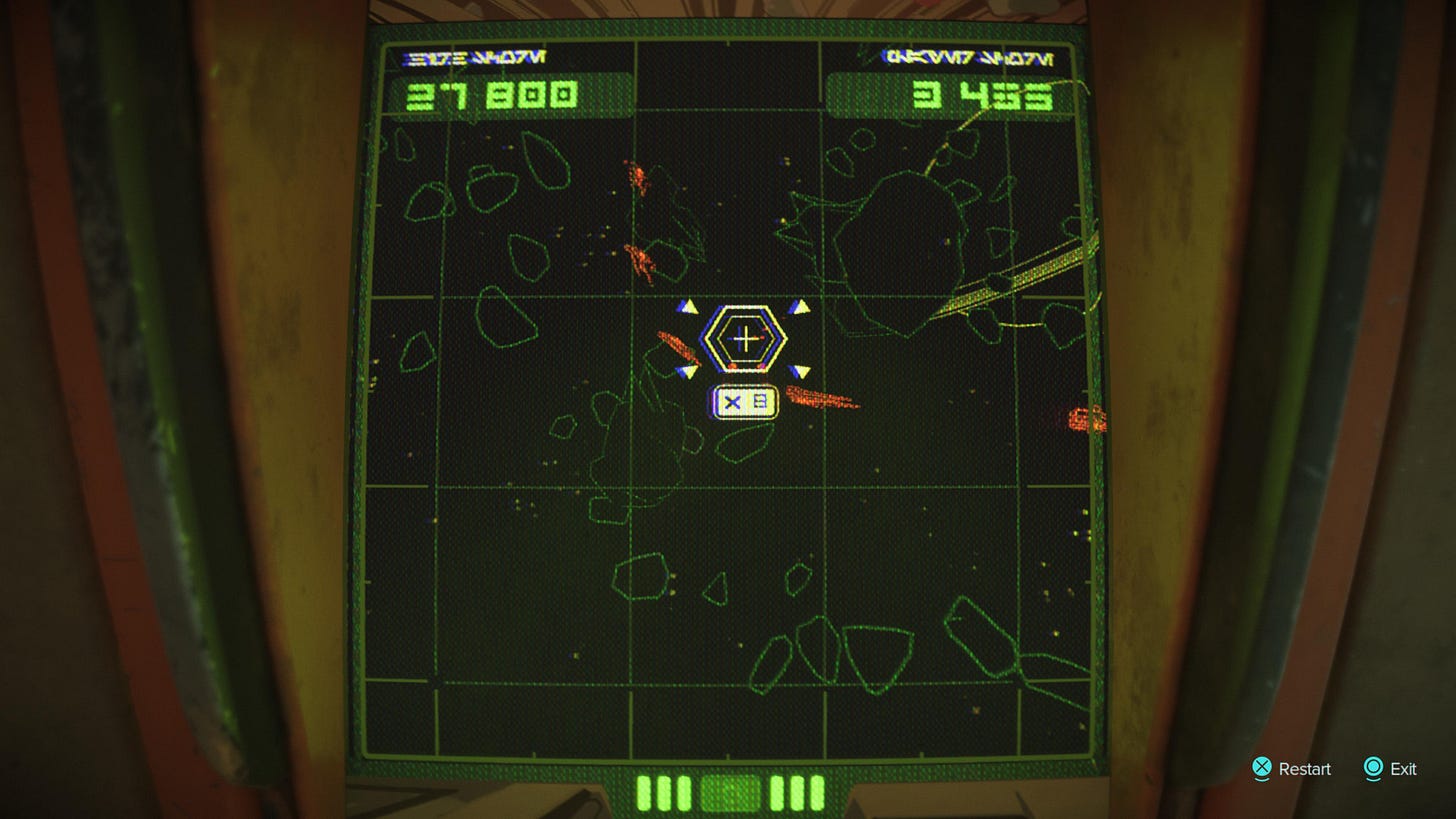
At face value, it’s fairly facile stuff: Crouch when you want to skulk around slyly and get behind cover or amid tall grass to hide. There’s a button for silent takedowns and the secondary fire function on your firearm is a stun blast that quietly knocks down enemies and takes an eternity to recharge. That’s about all there is to it really. But it’s actually the environment and Nix’ abilities that really inform Star Wars Outlaws’ approach to stealth. For starters, there are no obvious hidey-holes (looking at you here, rooftop gardens, rose petal carts, wagons full of hay and wells) that let you hide in peace, which means you can’t commit to entering an area without having a clear exit strategy in mind.
Equally important is finding the best way to enter an area. I was amazed at the difference finding a slightly concealed entrance made to my overall approach. The lesson in this game is never to take the obvious entrance. Yep, it’s somewhat obvious, but illustrated magnificently here. Now once you’re in, some environments might be laid out across a number of levels — which can work both to your benefit and detriment (if someone’s standing on the level above and looking down at you, for instance). Others might require a bit more guile on your part in terms of making your way across flat terrain. And depending on the lay of the land, quite literally, your strategies will change. So too will your deployment of Nix, who can distract enemies, attack them, steal from them, cause certain containers to explode and disable alarm buttons. In other words, he’s a cute and cuddly version of the hacking abilities from the Watchdogs games.
This is great game design, but it took me a fair bit of time to grasp all of it. I’m willing to wager that of my time spent on the game so far, at least a quarter has gone in missions that were eventually aborted because Kay was captured, killed or trapped in a facility lockdown. There was a point when I began seriously questioning if I even understood what was happening. You see, I’d find myself starting to sneak into a facility or a particular loosely-guarded area, when all of a sudden, I’d be exposed and every single goon who was ever born on that particular planet or moon would come charging out to get me.
It stopped being frustrating after a while, and just became tragic. How on earth was I going to even pass a two-line comment on the game if I couldn’t even clear the first tranche of main missions? Traditionally, main missions tend to scale up gradually in difficulty, so as to give the player a chance to learn. But here, I was running into walls from the get-go — literal and metaphorical ones. I’d never heard of the concept of ‘gamer’s block’, but there I was. Following my plea for assistance to friends (who shall remain unnamed), all I met with was their contempt and derision. I can still hear them laughing and taunting me, as they squealed viciously, “Git gud! Git gud!”
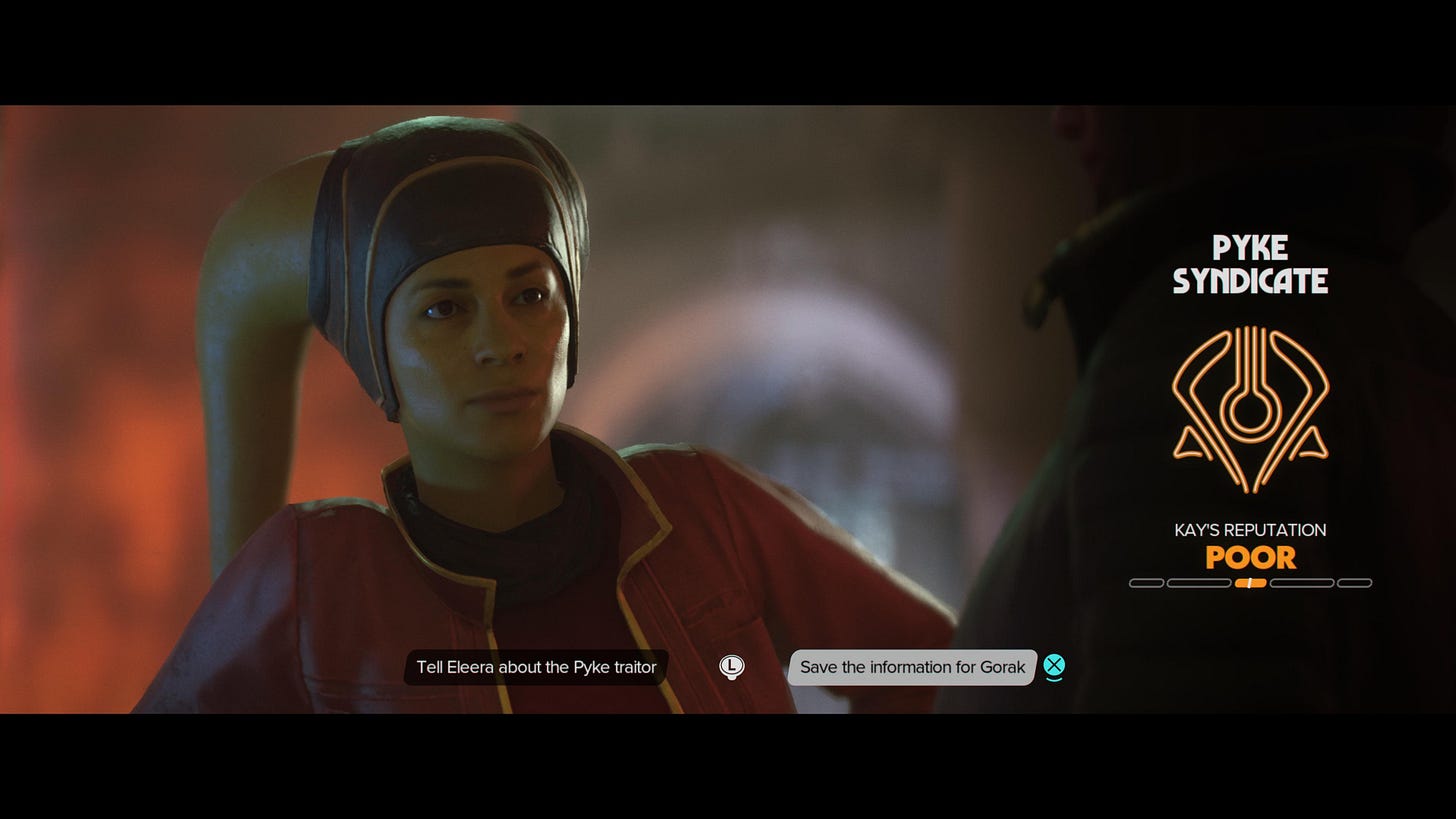
And then I began to see what I was missing — avenues and branching paths in the game design to better ‘stealth’ my way through situations. Having spent a fair few tries attempting to infiltrate a particular base via an obvious approach, I walked around the area. Lo and behold, there was a sneaky little vent through which to make my way! No sooner than the gamer’s block lifted did I begin to relish the game’s level and mission design. I took particular delight in the fact that when you return to an area after escaping a manhunt or biding time to lose a high ‘wanted’ level (works the same way as GTA games, except here, you get Death Troopers hunting you after a certain point), the arrangement of enemies is usually slightly changed, requiring you to tweak your strategy. Further, the main quests are all extremely cinematic in both their execution and ambition, and leave you with a deep sense of satisfaction and accomplishment. Without spoiling too much, an early mission that sees you infiltrate an Imperial space station is absolutely exhilarating, and conjures up flashbacks of some of the Star Wars films and games.
Being roguish
But Kay’s existence doesn’t rely solely on main quests and sneaking around. There are tonnes of side missions available — most of which influence her standing with the cartels. Please one of them, and you can bet you’ll be displeasing another by the same or greater measure. And these missions tend to vary greatly in terms of what is needed of you: Some require a little bit of snooping, while others could require you to pilot a starship through a debris field and into a space station infested with Imperial forces in order to drop off some contraband.
At first, it seemed logical to to try and keep all the syndicates on-side. However, with reputation (your currency with these syndicates) drops being far steeper than the rises, I swiftly abandoned the approach. It also didn’t help that Kay (in my playthrough) was not thought of all that highly by any of them. And so I began to take on missions that would truly get me in the good books of just one of those syndicates. This system provides an instant boost to Star Wars Outlaws’ replayability. I took quite a liking to the varied fare on offer in terms of the syndicate quests and side missions — which to me is a sign of a good game, because at the end of the day, it’s the strength of the side content that make an open-world game. And then, of course, there are the vehicles.
The Trailblazer is fun to fly — and is a lot less complex in its handling than the starships at your disposal in Starfield and Star Wars: Squadrons. Space dogfights are gripping and feel fair. For terrestrial traversal, there’s the speeder bike, which handles less smoothly, but can generate a great deal of speed and get you from A to B rather swiftly. The best thing about the vehicles is that they serve as a nice distraction from the staple on-foot stealth gameplay, and so you’ll find yourself cherishing your time with them.
Story so far
As a consequence of the aforementioned gamer’s block — and to a tiny extent, the heckling that followed — I’ve not made nearly enough progress to commit to a final rating for Star Wars Outlaws. But there are a few indicators that are quite instructive. The universe seems fresh and in the absence of the Force, it feels like a new beginning for videogames in this franchise. The storyline is compelling, characters are well fleshed-out and the gameplay, for the most part, has been quite gripping. One of the game’s strongest suits is the manner in which it encourages you to think outside the box in terms of how you approach each puzzle, that is to say, each stealth mission. Best of all, not once did I miss the comforting feel of a lightsaber in my hand or the knowledge of the Force in my mind.
On the flipside, I did not find myself overly impressed by the graphics. It’s been a while since I last saw an Ubisoft-published title with spectacular graphics. They usually tend to be good, rarely great, and in that regard, Star Wars Outlaws is no outlier. I was extremely disappointed by the extended loading sequence that greeted me every time I tried to take-off or land with the Trailblazer. Furthermore, that Massive Entertainment went the Starfield route (at launch anyway) and denied players the chance to manually land and take-off with their starship was a missed trick. I also found the lack of checkpoints in longer missions a bit vexing, because all that backtracking took me an absolute age. Equally infuriating was the fact that my save files would conspire to fling me a few 100 metres away from where I’d saved in order to ensure easy access to a particular route. And finally, I was a bit underwhelmed by the game’s photo mode that seemed unable to provide the sort of crisp focus that I desired on images.
Only time will tell if these quibbles manifest into full-fledged issues or remain minor complaints. I should hasten to add that I have not yet completed the game, and intend to continue playing it in the leisurely and exploring every nook and cranny of the diverse worlds on offer. Given the clear replayability of this title (referenced above), I might even give it another whirl. But at this point, I’m satisfied that no matter what comes next, it won’t contradict my opinion. Now should it do so, I’ll roll out a whole new piece on that matter. Until then though, keep an eye out for the game’s August 30 release date, and maybe check it out. It’s an exciting take on Star Wars that no fan should miss. Casuals — in terms of the franchise — should also give it a go.
Game being reviewed on PlayStation 5. Review code provided by publisher





